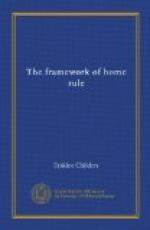Roebuck, who led the Radicals in Canadian matters, had some of the faults of Papineau and Mackenzie; yet posterity should give him and his comrades credit for a constructive Imperialism which the great men of his day lacked. It is now known that he and Sir William Molesworth powerfully influenced Durham’s policy. In a paper he drew up at Durham’s request on the eve of that nobleman’s departure for Canada he sketched a plan, imperfect in some details, but wise in broad conception, for pacifying the Canadas, and went further in elaborating a scheme, also defective, for the Confederation of British North America under the Crown on the lines conceived by the despised demagogue, Mackenzie.[27] But the two men who, by influencing Durham, probably did most to save Canada for the Empire and to lay the foundations of the present Imperial structure, were Charles Buller, the Radical M.P., and Edward Gibbon Wakefield, both of whom accompanied the new Governor-General to Canada, and who are generally believed to have inspired, if they did not actually write, the greater part of the celebrated Report which became the Magna Charta of the self-governing Colonies of the Empire.
A word about the events which ended in the publication of this Report. Durham reached Canada at the end of May, 1838, and in November was recalled in disgrace for exceeding—strange as it seems!—the almost absolute powers temporarily entrusted to him. He was an extraordinary mixture of a despot and a democrat, an extreme Radical in politics, an autocrat in manners, as vain and tactless as he was generous and sincere, making bitter enemies and warm friends in turn. He began by winning and ended by estranging almost every class in both Provinces of Canada, and returned to England to all appearances a spent and extinguished meteor. There is some truth, perhaps, in Greville’s observation that, had he been “plain John Lambton,” he would never have been chosen for Canada. It is certain that those who sent him there little dreamed of the consequences




